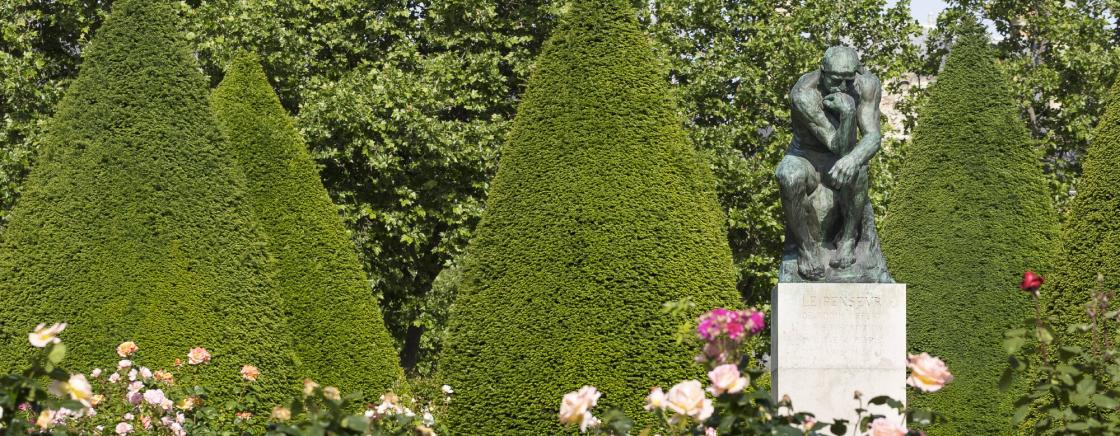
Today we have the pleasure to introduce you to a world famous work of art: Rodin’s Thinker. It embodies the beauty, power and depth of sculptural art in the City of Light.
Are you ready to learn the secrets of this illustrious sculpture? Let's go together to the 7th arrondissement of Paris, not far from Les Invalides. The mythical Rodin Museum opens us its doors.
This sculpture is an artistic gem in Paris, offering visitors a unique opportunity to contemplate a world-renowned masterpiece. It bears witness to the diversity of art and the rich cultural heritage of the city. The Thinker illustrates the passion and talent of the artist who brought this timeless work to life. Even though the time goes by, the fascination and admiration of the spectators never tire. If you are attracted by the depth of human thought and the beautiful Parisian hotels, this sculpture offers a captivating glimpse of the power of sculpture and our Hotel Le Monna Lisa is committed to highlight this subtle and precise art of living.
Auguste Rodin said: “When a good sculptor models the human body, they not only represent the muscles, but also the life that animates those muscles.”
RODIN: THE TIMELESS DANCE OF FORMS AND EMOTIONS THROUGH SCULPTURE
Auguste Rodin, born November 12, 1840 in Paris, was one of the most influential sculptors of his time and a pioneer of modern art.
We have all heard or seen the famous sculpture The Thinker, but do we really know all its secrets and symbolism?
The father of modern sculpture, he was a renowned sculptor, painter, engraver and decorator. Visionary and avant-gardist, he quickly became a reference in the highly confidential and codified world of sculpture.
He began his artistic education at the age of 14 and entered the Special School of Drawing and Mathematics, where he developed his artistic skills. Later, he studied at the École des Arts Décoratifs and the École des Beaux-Arts in Paris.
In 1875, Rodin travelled to Italy to study works of art of classical and Renaissance sculpture. This journey had a great influence on his future work, inspiring him to take a more naturalistic and expressive approach to sculpture.
Did you know that the artist presented his most famous work, "The Thinker" in 1880? Although acclaimed by some, the sculpture has been controversial for its realistic and powerful representation. Finally, Rodin gained recognition and was admitted to the Académie des Beaux-Arts in France.
You can imagine that this was a real springboard and revealed all the creative genius and the now famous sculptor and explorer of human emotions. He received several phenomenal commissions, including the Porte de l'Enfer for the Musée des Arts Décoratifs in Paris and the Monument à Balzac.
In 1919, Rodin donated his studio, sculptures and art collection to the French State. This led to the creation of the Rodin Museum in Paris, which is dedicated to the preservation and promotion of its artistic heritage.
He left his mark on art history with his innovative vision of sculpture. His powerful and expressive style paved the way for new forms of artistic expression, influencing future generations of artists.
HUMAN REFLECTION ENGRAVED IN STONE
Let's take a closer look at his iconic masterpiece: The Thinker. It is a bronze sculpture that embodies deep reflection and human contemplation. Created between 1880 and 1902, this work of art has become an icon of Western art and one of the most famous sculptures in the world.
Rodin's Thinker represents a naked man sitting on a rock, in a powerful and introspective pose. Measuring about 1. 90 metres tall, he is a muscular man, legs bent and torso slightly tilted forward. His face is marked by an intense expression, wrinkled eyebrows and a tight jaw, testifying to the depth of his thoughts and the concentration of his mind.
His posture reflects the tension and intellectual effort that accompanies reflection. He is plunged into deep contemplation, his gaze turned to the ground, while his right hand supports his chin and his left hand rests on his thigh. This pose evokes the intensity and seriousness of reflection, giving the impression that man is absorbed in his thoughts, isolated from the outside world. The wrinkles of the forehead and the lines of the face reflect the inner torments, doubts and existential questions that man faces in his search for meaning.
The way Rodin has managed to capture man's interiority and emotions is captivating. The muscles of the body are rendered with striking precision, revealing the strength and physical power of the body. The veins and folds of the skin are meticulously represented, giving an impression of realism and authenticity to the sculpture.
He invites spectators to question their own existence. Sculpture has a universal resonance, as it expresses the fundamental concerns and questions of humanity.
This iconic sculpture continues to fascinate and inspire generations of artists and spectators, testifying to the depth and relevance of Rodin's work to the global art landscape.
LE MONNA LISA, THE PARISIAN HOTEL WHERE THE SCULPTOR’S ART OF LIVING TAKES ON ITS FULL MEANING
The Hotel Monna Lisa, like an extension of Rodin's work, perfectly embodies the sculptor's art of living. Like the Thinker frozen in his reflection, the hotel invites its guests to an inspired contemplation, offering them a haven of peace in the heart of Parisian bustle.
The Monna Lisa presents this art of living with meticulous attention to detail. The common spaces become exhibition galleries, highlighting the shapes and movements of the stone. The rooms, real interior sculptures, are designed with harmony and balance, where classic lines and contemporary nuances blend in perfect symbiosis. Each corner is designed to offer absolute comfort, inviting travelers to relax and soak up the beauty of their surroundings.
In short, the Hotel Monna Lisa embodies the sculptor's art of living in all its splendor. Every aspect of the hotel is a gem in itself, elegant and harmonious.
Between the artistic heritage of Rodin’s work and the magic of the art of living of the sculptor in the hotel, visitors discover a subtle connection where the expression of stone carving blends harmoniously with hospitality. Every detail is carefully crafted to charm the senses of the guests. A stay at the Monna Lisa becomes a unique and unforgettable experience, allowing travelers to be carried away in an atmosphere steeped in history and culture.
Photo credits:
https://fr.wikipedia.org/wiki/Mus%C3%A9e_Rodin#/media/Fichier:Le_mus%C3%A9e_Rodin.jpg
